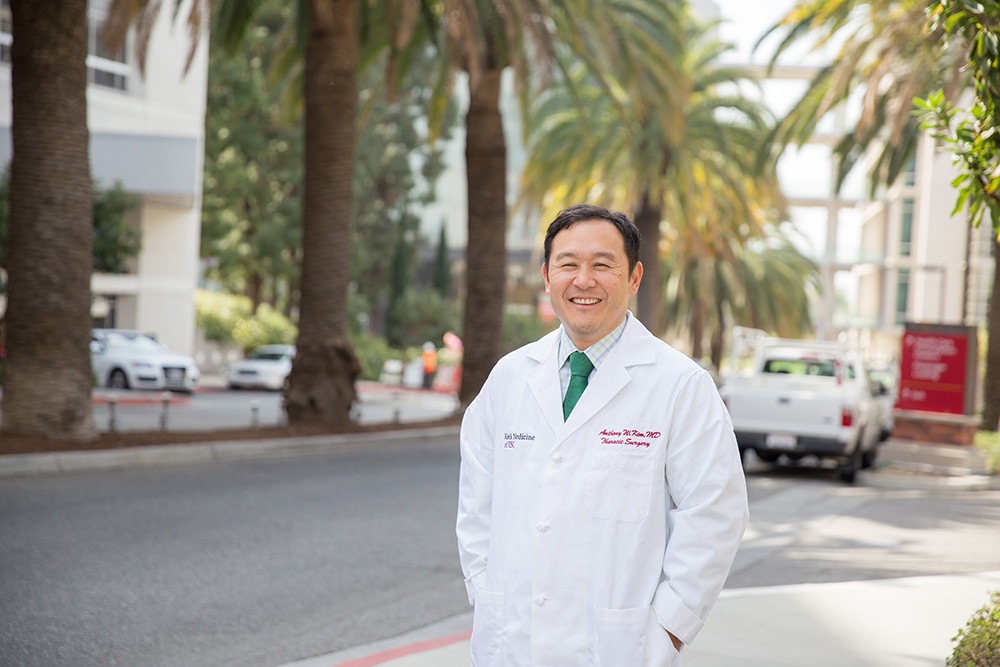
Anthony Kim, MD, chief of thoracic surgery at Keck Medical Center of USC, shares his advice.
When I took over as the chief of thoracic surgery at Keck Medical Center of USC, we definitely had room for growth. Since then, we have expanded our practice every year and built a national reputation for the skill of our surgeons and our quality of patient care.
Here are a few principles to remember for building your own exceptional program.
1. Recruit surgeons who are great doctors and even better people.
I’m fiercely proud of my team’s surgical skills, but that’s not the only reason I recruited them. Every single surgeon on my team is a deeply empathic individual who embodies the golden rule for each and every patient. There is a passion for treating every single patient that is uniquely profound. This passion also translates in other areas of interest, including each surgeon’s fascination for their particular area of research.
I am lucky to have a team of thoracic surgeons who collectively have a depth and breadth of research in translational sciences, population health sciences, innovation and other areas that can compete with any major academic center internationally. Their different perspectives help me to continually examine and improve our practice.
2. Build an outstanding team at every level.
I would be remiss to think only of my surgeons when describing the successful program we have built thus far. Our patients will spend at least as much time with our physician assistants, coordinators and front office staff as they will with me and my colleagues.
Over my career, I know of too many stories where patients have undergone technically successful surgical procedures but feel minimized in value as individual human beings along the way. I truly believe that making sure that each patient feels heard, seen, and cared for is a critically important part of the successful healing journey.
In fact, “journey” is a perfect word to describe the relationship that each one of us believes we embark upon with our patients. Our team has the singular mission to ensure that a patient has a positive journey at every single point of contact with our entire group.
Beyond being good for the patient, beyond it being good for building our program, and beyond it having tremendous value for word of mouth, it is simply the right thing to do.
3. Remember the value of each team member every day.
Patients are not the only ones who need to know that they are seen and respected. You’ll never regret taking a moment to praise a member of your staff for a job well done.
Getting to know everyone on our teams and learning a little bit about them helps all of us to understand each other’s perspectives and plays right into the crux of why we all went into health care: to connect with other people. It is a vitally important point in keeping your team happy, motivated and invested in the program.
Perhaps more importantly, respecting all those who are on your team empowers each team member to lead in their own personal way. Their individual leadership in turn ensures that our patients will receive the very best care at every level.
4. Come up with a collective team mission statement as a program.
One key element to the success of our team is having a collective purpose. Three years ago, as a team-building exercise, our team agreed to meet, express and codify what our group mission statement was to be. The amalgamation of various perspectives and thought processes led us to one universally common and core principle we shared: Patient First.
Since that time, we have returned to this theme to guide all that we do. This “True North” has been extremely helpful in clarifying priorities when challenges from external forces to delivering the best care present themselves.
At other times, it has been a rallying cry that has bonded us together. Even now when we have other similar retreats, we return to the Patient First theme to guide the other great things that we do and offer.
Is that something I could have come up with on my own and simply handed down as an edict? Of course. But coming to this mission statement together as a whole team imbued it with real meaning for everyone. I know that every member of my team understands the why of Patient First, and I know that they will pass that spirit on to new staffers as a part of the culture.
5. Make sure everyone knows their voice is valued.
My team knows me as someone who will listen to them. My door is always open. In many ways they have alerted me to potential issues that I might not have been able to see from my point of view. Their different perspective — and knowing that they will be heard when they give it — has allowed us to avoid many potential problems entirely.
Additionally, my team has showered me with good — no, great — ideas for improving our processes based upon the free and open communication we all share. Getting input from diverse perspectives has helped us improve and grow our whole program every single year.
Keck Medical Center of USC
Anthony Kim, MD, is chief of thoracic surgery at Keck Medical Center of USC. Our doctors are leaders in the diagnosis and treatment of diseases affecting the thoracic cavity, including the lungs, esophagus, stomach, mediastinum and chest wall. We are knowledgeable in all aspects of managing diseases of the chest and foregut, from complex surgeries to minimally invasive treatments.
Topics
